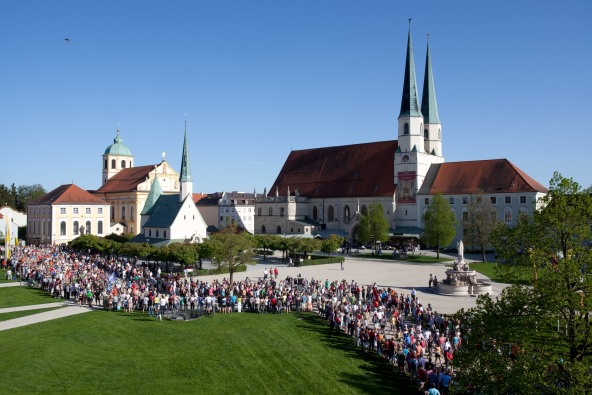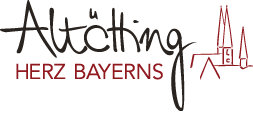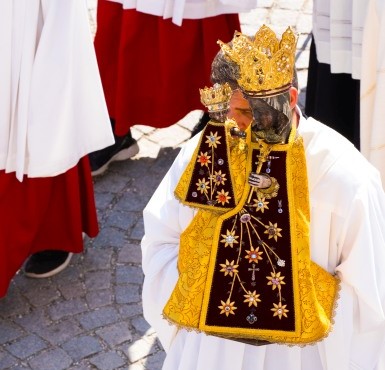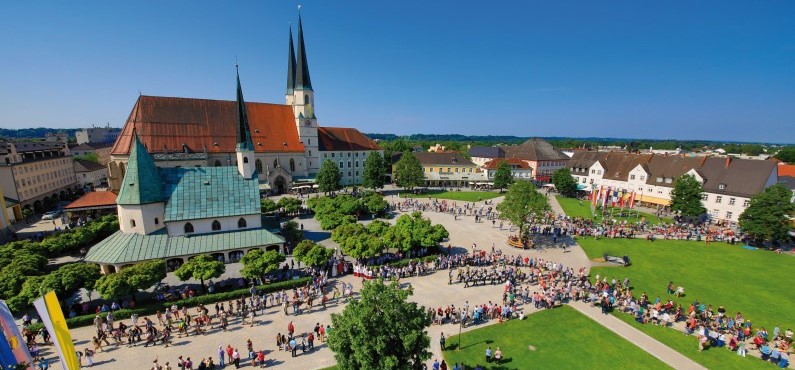Religious people have been going on a pilgrimage to Altötting for around 1,200 years. Altötting has been the most important Marian pilgrimage site in German-speaking countries for well over 500 years. Learn interesting facts about the history of the spiritual centre in the heart of Bavaria and about the offers currently available for your pilgrimage.
The Pilgrimage Site of Altötting
Pilgrimages to Altötting, Now and Then
Pilgrimages have been very popular since the Middle Ages. People travel in groups, often accompanied by a priest, to places of religious significance to present their petitions and prayer requests to God, to repent or to give thanks. To this day, Altötting has been the annual destination of numerous pilgrims visiting the Black Madonna of Altötting, either on foot, by bus or by car, individually or in groups. Find out how to go on a pilgrimage to Altötting and how the pilgrimage office can assist you in organising your pilgrimage.
Why is Altötting a Pilgrimage Site?
The place where Altötting is located today was probably already an important cultural centre in Celtic times. The town gained in importance when Karlmann, the great-grandson of Charlemagne and King of Bavaria and Italy, moved his royal court to Altötting in 865. The great church treasury donated by him also included a relic of the arm of the Holy Apostle Philip. As a result, Altötting became one of the pilgrimage sites where apostle relics were worshipped. Altötting can thus look back on around 1,200 years of pilgrimage history!

The Marian Pilgrimage Site of Altötting
The picture of the "Black Madonna" carved from limewood has been in Altötting since the 14th century, where it is still worshipped today in the octagon of the Gnadenkapelle [Chapel of Mercy]. In the late 15th century, a miracle of the Virgin Mary is reported to have taken place there: a dead child returned to life upon its mother's supplication. Subsequently, many people sought shelter and help from the Mother of God of Altötting. Pilgrimages were very popular at that time, and the Chapel of Grace quickly became a centre of popular piety, which was intensively promoted by the princes of Wittelsbach in the following centuries. Today, there are more than 2,000 votive tablets in the chapel's walkway testifying to the long tradition of pilgrimages to Altötting.
Pilgrimages/Pilgrims‘ Journeys to Bavaria
Even though the terms pilgrimage and pilgrim’s journey are often used synonymously today, there are a few significant differences. The actual destination of a pilgrimage, which people usually travel to in groups, is the Gnadenkapelle. Traditionally, praying the rosary and singing religious hymns are part of a pilgrimage, so is celebrating a Holy Mass. In the case of a pilgrim’s journey, the route becomes a destination in itself, whereby the journey is concluded once a religious place has been reached. People contemplate along the way and seek to clarify questions and develop a new perspective on life. Such pilgrims often travel alone or in small groups, and their motives and goals for a pilgrimage are quite individual. Everyone is welcome in Altötting - whether he/she is on a pilgrimage or a pilgrim’s journey!
The Procedure of a Pilgrimage to Altötting
Pilgrimages are usually organised and carried out by parishes, dioceses and religious communities. If you are interested in a pilgrimage to Altötting, it is best for you to inquire with your local parish office. You can make single-day or multiple-day pilgrimages, either on foot, by bus or by car. Upon arrival in Altötting, the most important moments of a pilgrimage are the celebration of a Holy Mass and a visit to the Gnadenkapelle. Tip: pilgrims can take part in regular church services in Altötting or book a special service for their group.
Organising a Pilgrimage to Altötting
You may get in touch with several contact persons in Altötting to help you plan and organise your pilgrimage. The Pilgrimage Custody Office staff at the Kapuzinerkloster St. Magdalene [Capuchin monastery] will help you with your itinerary and registrations and will also organise Holy Masses and an introductory talk. The Altötting Pilgrimage and Tourism Office will help you book accommodation and sightseeing tours and will also suggest excursions and provide general information. Important contact persons for your pilgrimage to Altötting can be found here!


